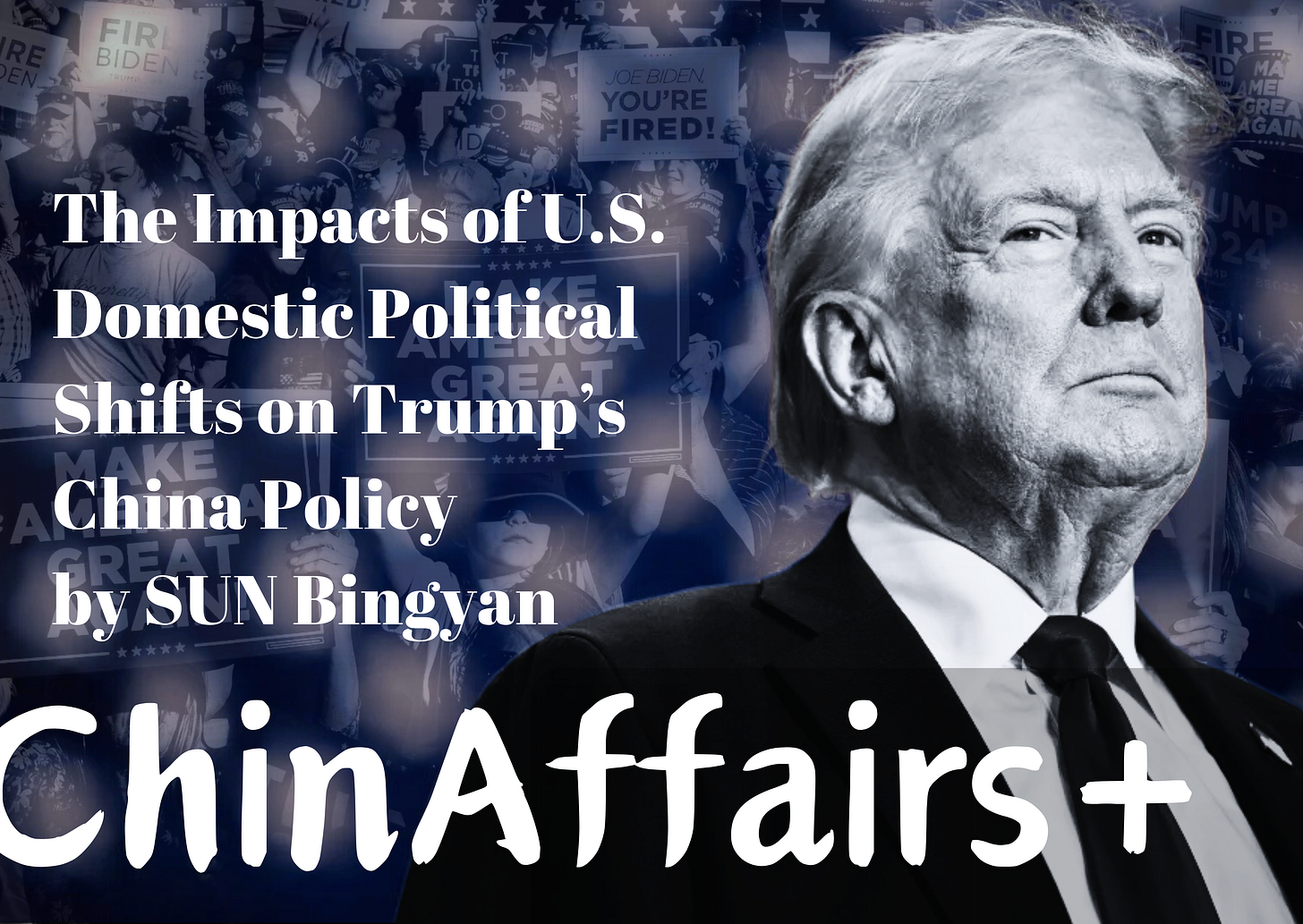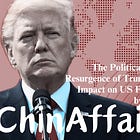The Impacts of U.S. Domestic Political Shifts on Trump’s China Policy by SUN Bingyan
Frictions in China-U.S. relations rooted in domestic U.S. politics rather than diplomatic consideration alone.
Welcome to the 31th edition of our weekly newsletter! I am SUN Chenghao, a fellow with the Center for International Security and Strategy (CISS) at Tsinghua University, Council Member of The Chinese Association of American Studies and a visiting scholar at the Paul Tsai China Center of Yale Law School (fall 2024).
ChinAffairsplus shares Chinese academic articles focused on topics such as China’s foreign policy, China-U.S. relations, China-European relations, and more. This newsletter was co-founded by me and my research assistant, ZHANG Xueyu.
Through carefully selected Chinese academic articles, we aim to provide you with key insights into the issues that China’s academic and strategic communities are focused on. We will highlight why each article matters and the most important takeaways. Questions or criticisms may be addressed to sunchenghao@tsinghua.edu.cn
Today, we have selected an article written by SUN Bingyan, which focuses on the impacts of U.S. Domestic Political Shifts on Trump’s China Policy.
Summary
In analyzing and forecasting the current U.S. administration’s China policy, the field of international relations has predominantly relied on the “Thucydides Trap”(修昔底德陷阱) framework, positing that, against the backdrop of long-term China-U.S. strategic competition, a hardened policy during Trump’s second term appears structurally inevitable. This paper argues that, beyond structural determinants, the evolution of the U.S. domestic political dynamics serves as a critical internal catalyst, intensifying the assertiveness and severity of Trump’s China policy.
These domestic developments mainly include: the qualitative escalation of trade protectionist forces, the convergence of populism with anti-China sentiment, and the localization of anti-China rhetoric, which has elevated China-related issues in grassroots political discourse. These three factors may amplify the constraints on Trump’s second-term China policy, subjecting China-U.S. relations to heightened friction rooted in internal U.S. politics rather than diplomatic considerations alone.
Why It Matters
On April 2nd Eastern Time, the U.S. announced the imposition of “reciprocal tariffs” on all its trading partners, a move that could deliver a major shock to the global trade system and economy. The Trump administration views tariffs as a rapid means to correct trade deficits and generate wealth for the U.S., a strategy that has quickly provoked retaliatory measures from numerous governments. China has responded by imposing a 34% tariff on American goods.
Since Trump took office, a general consensus has emerged among both academic and policy communities in China and the U.S. that bilateral relations may face increasing challenges. Trump’s unpredictable and unconventional policy style further heightens the possibility of unexpected crises between the two countries. At present, China is not the top priority in U.S. foreign policy, as attention remains partly diverted by the Russia-Ukraine conflict.
Trump’s desire to quickly withdraw from the Russia-Ukraine entanglement is also motivated by his intention to reallocate strategic focus to the Asia-Pacific region in order to confront China, seen as a principal “competitor”. Therefore, from the Biden to the Trump administration, the structural factor of “strategic competition” with China has remained unchanged.
However, is Trump’s China policy also influenced by changes in U.S. domestic affairs? This is a question that Chinese academia is equally focused on—whether the characteristics of the current U.S. government’s policy toward China will outlast Trump. This article argues the logic of the Thucydides Trap will structurally compel the Trump administration to adopt increasingly confrontational policies toward China. At the same time, shifts in domestic U.S. politics may render Trump’s second-term China policy more trade-centered and populist in rhetoric. These factors will likely inject further uncertainty into the bilateral relationship, surpassing the bounds of traditional diplomatic channels.
Key Points
The Evolution of Trade Politics & Trump's China Tariff Policy
The tariff war against China initiated during Trump's first term is often interpreted through the lens of China-U.S. competition in the trade domain. However, from the perspective of U.S. domestic trade politics, even without the overarching framework of strategic competition, the Trump administration would likely have imposed similarly aggressive tariffs. The underlying impetus for these policies stems from decades of transformation in the U.S. trade politics, marked by the gradual rise of protectionist forces and their qualitative political impact following the 2016 election.
The Gradual Rise of Protectionist Forces
Over decades, the growing influence of U.S. protectionist factions culminated in Trump’s first election. Prior to Trump’s dominance over trade policy, U.S. —from the Cold War era onward—adhered to “a rising tide lifts all boats” (水涨船高 shuǐ zhǎng chuán gāo) rationale, viewing free trade as universally beneficial. Free trade agreements (FTAs) were seen as enabling U.S. producers to secure cheaper supply chains, reduce production costs, expand market dominance, and drive economic growth, which in turn fueled job creation and prosperity. Guided by this logic, successive U.S. administrations, beginning with the Reciprocal Trade Agreements Act (1933), spearheaded global tariff-reduction negotiations and systematically weakened protectionist institutions, shifting tariff-setting authority from Congress to executive agencies.
The Wider Political Impact of Manufacturing Workers
However, as predicted by comparative advantage theory, the long-term pursuit of free trade disproportionately impacted low-skilled, labor-intensive industries in the U.S., leading to mass unemployment and wage stagnation. Crucially, successive administrations failed to adequately compensate displaced manufacturing workers, fueling resentment against free trade and galvanizing support for protectionist candidates. This simmering backlash reached a tipping point in 2016, when Trump’s protectionist rhetoric secured critical votes from manufacturing workers in Rust Belt swing states. Consequently, Trump and subsequent presidential contenders have increasingly prioritized courting this voter bloc.
To consolidate support from manufacturing workers, Trump aggressively opposed FTAs and imposed sweeping protectionist tariffs during his first term. In his second term, he is likely to intensify his “champion of the working class” persona, doubling down on tariff policies. Regarding China, continued tariff escalations would derive not merely from strategic competition but also from a deeper, politically calculated fear of domestic protectionist backlash.
The Transformation of Populist Politics & Trump’s Hardline Posture Toward China
Since the era of Andrew Jackson, populism has persisted in the U.S. political life, manifesting in diverse ideological forms. Historically, American populism has been characterized by demagogic politicians mobilizing grassroots resentment against political and economic elites, through anti-establishment rhetoric to secure electoral victories, followed by policy agendas aligned with their supporters’ grievances. Trump’s 2016 election and subsequent governance epitomized this tradition. By stoking anger among disenfranchised white working-class voters toward elites, Trump secured power and pursued a range of anti-establishment policies.
Traditional populist politics has obvious inward characteristics, which are not closely related to foreign countries and foreign policy. However, after Trump took office, populism exhibited novel features. It fused anti-establishment fervor with hostility toward globalization and China, reshaping relations. This shift stems from a perceived linkage: After the Cold War, the U.S. participation in globalization coincided with deepening China-U.S. economic ties.
Populists who support Trump conflated these processes, framing them as evidence that Washington’s elites prioritized corporate profits (via outsourcing production to China and importing cheap goods) over addressing domestic deindustrialization, wage stagnation, and middle-class decline. In their narrative, Washington Establishment Faction enabled China’s rise at the expense of American workers, exacerbating wealth gaps and eroding manufacturing jobs.
This anti-China populist logic ensures that a second Trump term would intensify confrontational policies toward China. To consolidate his “drain the swamp” agenda, Trump may further purge establishment figures within the U.S. government who advocate for pragmatic engagement or oppose punitive tariffs. His “safeguard the middle class” platform could pressure U.S. firms to reshore manufacturing from China, ostensibly to revive domestic jobs. Moreover, to project his image as a populist “man of action”, Trump might escalate tariffs or trade restrictions beyond strategic necessity, driven by performative anti-China rhetoric. Such measures would jeopardize existing China-U.S. economic cooperation, subjecting bilateral trade and investment to unprecedented populist-driven volatility.
The Shift of Subnational Politics & The Public Sentiment Foundation on Trump’s China Policy
Amid escalating political polarization in the U.S., bipartisan competition at the subnational level has increasingly weaponized decades of China-U.S. engagement. Cooperative initiatives, once hailed as diplomatic achievements, are now exploited by local politicians to attack rivals and inflame anti-China sentiment. This has fueled grassroots hostility toward China, elevating public scrutiny of China-related issues and constraining federal policymaking.
The 2022 Missouri Republican Senate primary exemplifies this trend. In this solidly red state, candidates Eric Schmitt and Eric Greitens, all leveraged China as a campaign wedge. Both accused each other of “softness on China”, by highlighting their opponent’s past economic collaborations with Chinese entities during their tenures in Missouri state government. Such tactics reframe pragmatic engagement as a political liability, embedding anti-China narratives into local electoral discourse.
As subnational politicians increasingly vilify bilateral cooperation, public awareness of China-related issues has surged. Consequently, Trump’s federal-level China policy will face heightened grassroots scrutiny, amplifying the political risks of deviating from public expectations. If Trump pursues moderation on contentious issues contrary to prevailing anti-China sentiment, Democratic opponents at the local level will weaponize such decisions, subjecting his administration to intensified attacks and pressure.
Moreover, the entrenchment of anti-China sentiment at the subnational level has exacerbated challenges for Chinese enterprises investing in the U.S., as regulatory and political hurdles increasingly originate from state or municipal governments rather than federal mandates. This undermines prospects for mutually beneficial cooperation in emerging industries, further straining bilateral relations.
Conclusion
The “Thucydides Trap” framework explains why the Trump administration designated China as a strategic competitor during its first term and predicts the likely continuation—even expansion—of competition in a potential second term. The narrowing China-U.S. power gap remains the structural driver of this adversarial trajectory. However, beyond this macro-level dynamic, domestic political forces—specifically, the qualitative rise of trade protectionism since 2016, Trump’s reinvented populist politics, and the localized anti-China rhetoric in subnational elections—have emerged as critical accelerants of U.S. inflexibility and confrontational posturing. The interplay of these factors collectively ensure that China-U.S. relations under a second Trump administration would confront challenges resistant to traditional diplomatic or negotiated resolution.
About the Author
Sun Bingyan孙冰岩:Dr. SUN is a lecturer at the University of International Relations and Vice Director of Research Center for Intellectual Property and Technological Security. He is also a part-time researcher at Institute for Global Cooperation and Understanding (IGCU) of Peking University, with research interests in US politics and foreign policy, inter-branch politics in the US, and China-US relations.
About the Publication
The Chinese version of this article is published in China Review (《中国评论》). It is currently the only Chinese current affairs and political magazine that is publicly available for sale in Chinese Taiwan and Hong Kong/Macau regions. It was officially launched in Hong Kong in January 1998, published and distributed by Hong Kong China Review Culture Co., Ltd., providing constructive ideas and opinions for China’s opening up and development.











